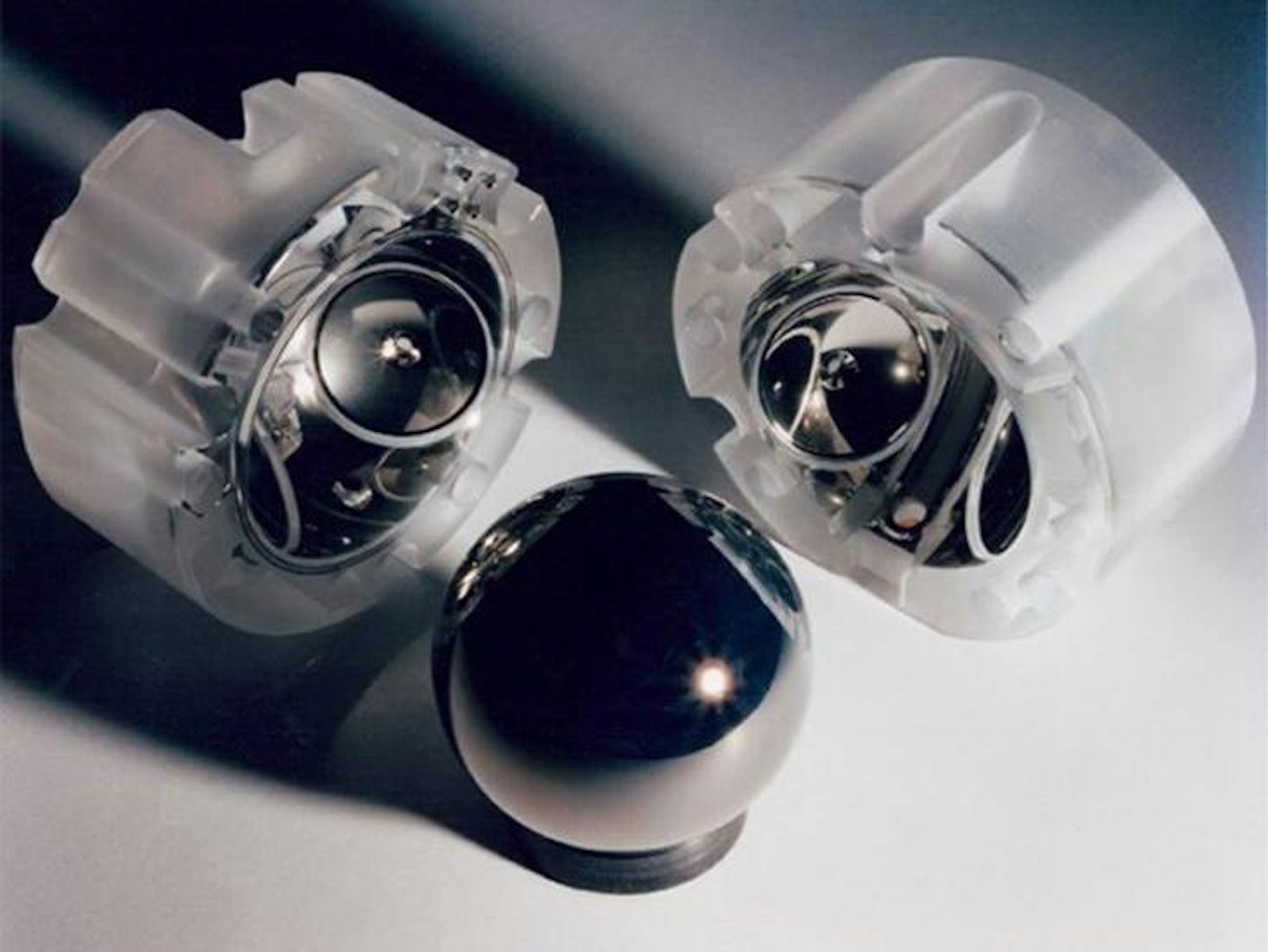If you’ve ever tried to give yourself a haircut, you know just how hard it is to make something precisely symmetrical. We value symmetry so highly in part because it’s really hard to achieve. Here are five of the most symmetrical objects humans have ever crafted, and why they were so hard to make.
1. Gravity Probe B quartz gyroscope rotors
In 2004, Gravity Probe B (GP-B) was launched into space on a Delta II rocket with the mission of testing the theory of general relativity. The Earth-orbiting satellite included a set of gyroscopes that could measure two of the phenomena predicted by general relativity: the curvature of spacetime (the geodetic effect) and the distortion of spacetime by large objects (frame-dragging). In order to measure these things, the gyroscopes had to be incredible accurate. Being off by anything larger than one one-hundred-billionth of a degree every hour would ruin the experiment. Standard gyroscopes used on submarines and military aircraft, for comparison, are over ten-million times less accurate.
The key to building such an accurate gyroscope was creating perfectly symmetrical rotors, the quickly spinning elements that allow gyroscopes to maintain their orientation. These rotors had to be totally balanced, and completely homogenous inside as well. The GP-B team crafted these little spheres out of pure quartz blocks that were grown in Brazil and baked in Germany. The surface of each gyroscope is almost completely spherical, only about three ten-millionths of an inch away.
According to the Guinness Book of World Records, these are the roundest objects ever made. The Stanford team that worked on the spheres says only neutron stars are more spherical.
2. Avogadro Project silicon kilogram
Gravity Probe B’s only real contender, when it comes to perfect spheres, is the ball that should soon define a kilogram. This sphere is the result of The Avogadro Project, and its raw materials alone cost over a million dollars. The goal is to to supersede and replace the international prototype kilogram (IPK). The kilogram is the very last unit in the International System of Units (essentially, the metric system) that is still defined by a physical object—a cylinder made of platinum-iridium alloy—rather than physical principles. That cylinder currently sits under three nested bell jars in a climate-controlled vault just outside of Paris.
The problem is that the current IPK has lost a tiny bit of weight, in comparison with 40 similar cylinders held in other countries, which is a significant flaw in an object used to define a unit of mass. So the Avogadro Project has created two softball-sized, near-perfect spheres, made entirely of silicon-28 atoms, that should remain exactly one kilogram in perpetuity. They are made of silicon-28 that was purified in Russia, using old Soviet centrifuges that were once used to make nuclear weapons. Then the purified silicon was shipped to Germany, where it was grown into crystals.
The resulting sphere is only 25 nanometers away from being perfectly round, and probably will bump the GP-B spheres from their title sooner or later. “If you were to blow up our spheres to the size of the Earth, you would see a small ripple in the smoothness of about 12 to 15 millimeters, and a variation of only 3 to 5 meters in the roundness,” said CSIRO master optician Achim Leistner.
Now that the spheres are done, researchers in different countries will try to discern the exact number of atoms they contain, to get universal agreement on what exactly is the mass of a kilogram.
3. Lie group E8
Without the pesky realities of the physical world, mathematicians have been able to imagine incredibly symmetrical structures. Lie group E8, for instance, is a set of 248 different forms of symmetry that apply to a theoretical 57-dimensional object. The structure was theorized in the late 1800s, but it wasn’t until recently that researchers from the UK and Germany announced that they were able to create a physical system that represented E8 in the real world.
To see E8 symmetries, researchers cooled a crystal made out of cobalt and niobium to temperatures close to absolute zero. They then applied a magnetic field to that crystal, and as they increased the strength of that field, the spin of the electrons within it formed patterns that indicated they adhered to the E8 structure. Seeing this pattern arise suggests more than just the ability to build something very symmetrical—it also suggests that there are hidden symmetries in the quantum world that dictate how electrons organize themselves.
4. Taj Mahal
Most people will never interact with either the GP-B sphere or the silicon-28 kilogram sphere. But they can interact with a phenomenally symmetrical structure if they take a trip to India. The Taj Mahal was built as a mausoleum for emperor Shah Jahan to entomb his wife Mahal, who died during childbirth. Jahan wanted the building to represent harmonious relationships, and asked for the architect to design something bilaterally symmetrical. The result is a building that includes symmetrical details from the large-scale plan all the way down to decorative details.
The Taj Mahal is often cited as the key example of symmetry in buildings, but it’s hard to identify the most symmetrical building ever constructed, as many architects use symmetry prominently in their designs. For many years, in fact, mathematics and architecture were essentially the same discipline, and architects valued buildings that looked the same upon reflection.
5. Obsidian ear plugs
Creating something that’s really symmetrical by hand is difficult even with current technology. That is why these strikingly symmetrical pieces of ear jewelry, alleged to be centuries old, have been seized upon by conspiracy theorists, who argue that they couldn’t possibly have been made without modern tools. Archaeologists beg to differ. The tiny plugs are indeed remarkably well-made, but they weren’t made by aliens or hoaxers using modern machines—just by exceptionally skilled Aztecs. Archaeologists who have excavated the workshops where they were made say that many were crafted using stone, ceramic, and wooden hand tools.
“Not only is it amazing that they were produced with such skill and precision, but also that they have survived to the present day without being crushed,” says John Millhauser, an anthropologist at North Carolina State University who has found similar ear plugs in Xaltocan, just north of Mexico City. So while they may seem supernatural, they’re simply an example of incredible craftsmanship.
Rose Eveleth is Nautilus’ special media manager.






























